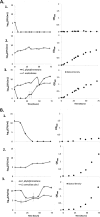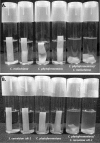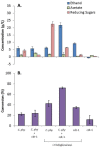Consortia-mediated bioprocessing of cellulose to ethanol with a symbiotic Clostridium phytofermentans/yeast co-culture
- PMID: 23628342
- PMCID: PMC3653780
- DOI: 10.1186/1754-6834-6-59
Consortia-mediated bioprocessing of cellulose to ethanol with a symbiotic Clostridium phytofermentans/yeast co-culture
Abstract
Background: Lignocellulosic ethanol is a viable alternative to petroleum-based fuels with the added benefit of potentially lower greenhouse gas emissions. Consolidated bioprocessing (simultaneous enzyme production, hydrolysis and fermentation; CBP) is thought to be a low-cost processing scheme for lignocellulosic ethanol production. However, no single organism has been developed which is capable of high productivity, yield and titer ethanol production directly from lignocellulose. Consortia of cellulolytic and ethanologenic organisms could be an attractive alternate to the typical single organism approaches but implementation of consortia has a number of challenges (e.g., control, stability, productivity).
Results: Ethanol is produced from α-cellulose using a consortium of C. phytofermentans and yeast that is maintained by controlled oxygen transport. Both Saccharomyces cerevisiae cdt-1 and Candida molischiana "protect" C. phytofermentans from introduced oxygen in return for soluble sugars released by C. phytofermentans hydrolysis. Only co-cultures were able to degrade filter paper when mono- and co-cultures were incubated at 30°C under semi-aerobic conditions. Using controlled oxygen delivery by diffusion through neoprene tubing at a calculated rate of approximately 8 μmol/L hour, we demonstrate establishment of the symbiotic relationship between C. phytofermentans and S. cerevisiae cdt-1 and maintenance of populations of 105 to 106 CFU/mL for 50 days. Comparable symbiotic population dynamics were observed in scaled up 500 mL bioreactors as those in 50 mL shake cultures. The conversion of α-cellulose to ethanol was shown to improve with additional cellulase indicating a limitation in hydrolysis rate. A co-culture of C. phytofermentans and S. cerevisiae cdt-1 with added endoglucanase produced approximately 22 g/L ethanol from 100 g/L α-cellulose compared to C. phytofermentans and S. cerevisiae cdt-1 mono-cultures which produced approximately 6 and 9 g/L, respectively.
Conclusion: This work represents a significant step toward developing consortia-based bioprocessing systems for lignocellulosic biofuels production which utilize scalable, environmentally-mediated symbiosis mechanisms to provide consortium stability.
Figures






Similar articles
-
Consolidated bioprocessing (CBP) performance of Clostridium phytofermentans on AFEX-treated corn stover for ethanol production.Biotechnol Bioeng. 2011 Jun;108(6):1290-7. doi: 10.1002/bit.23059. Epub 2011 Jan 31. Biotechnol Bioeng. 2011. PMID: 21280028
-
Engineering yeast with bifunctional minicellulosome and cellodextrin pathway for co-utilization of cellulose-mixed sugars.Biotechnol Biofuels. 2016 Jul 4;9:137. doi: 10.1186/s13068-016-0554-6. eCollection 2016. Biotechnol Biofuels. 2016. PMID: 27382414 Free PMC article.
-
[Cellulose hydrolysis and ethanol production by a facultative anaerobe bacteria consortium H and its identification].Sheng Wu Gong Cheng Xue Bao. 2010 Jul;26(7):960-5. Sheng Wu Gong Cheng Xue Bao. 2010. PMID: 20954397 Chinese.
-
Engineering microbes for direct fermentation of cellulose to bioethanol.Crit Rev Biotechnol. 2018 Nov;38(7):1089-1105. doi: 10.1080/07388551.2018.1452891. Epub 2018 Apr 10. Crit Rev Biotechnol. 2018. PMID: 29631429 Review.
-
Endowing non-cellulolytic microorganisms with cellulolytic activity aiming for consolidated bioprocessing.Biotechnol Adv. 2013 Nov;31(6):754-63. doi: 10.1016/j.biotechadv.2013.02.007. Epub 2013 Mar 6. Biotechnol Adv. 2013. PMID: 23473971 Review.
Cited by
-
Physiology, Genomics, and Pathway Engineering of an Ethanol-Tolerant Strain of Clostridium phytofermentans.Appl Environ Microbiol. 2015 Aug 15;81(16):5440-8. doi: 10.1128/AEM.00619-15. Epub 2015 Jun 5. Appl Environ Microbiol. 2015. PMID: 26048945 Free PMC article.
-
Recent advances of biofuels and biochemicals production from sustainable resources using co-cultivation systems.Biotechnol Biofuels. 2019 Jun 22;12:155. doi: 10.1186/s13068-019-1495-7. eCollection 2019. Biotechnol Biofuels. 2019. PMID: 31285755 Free PMC article. Review.
-
Metataxonomic profiling and prediction of functional behaviour of wheat straw degrading microbial consortia.Biotechnol Biofuels. 2014 Jun 12;7:92. doi: 10.1186/1754-6834-7-92. eCollection 2014. Biotechnol Biofuels. 2014. PMID: 24955113 Free PMC article.
-
Research advances on the consolidated bioprocessing of lignocellulosic biomass.Eng Microbiol. 2024 Feb 2;4(2):100139. doi: 10.1016/j.engmic.2024.100139. eCollection 2024 Jun. Eng Microbiol. 2024. PMID: 39629327 Free PMC article. Review.
-
Measurement Techniques to Resolve and Control Population Dynamics of Mixed-Culture Processes.Trends Biotechnol. 2021 Oct;39(10):1093-1109. doi: 10.1016/j.tibtech.2021.01.006. Epub 2021 Feb 8. Trends Biotechnol. 2021. PMID: 33573846 Free PMC article. Review.
References
-
- Shong J. Jimenez Diaz MR, Collins CH: Towards synthetic microbial consortia for bioprocessing. Curr Opin Biotech. 2012;2:1–5. - PubMed
LinkOut - more resources
Full Text Sources
Other Literature Sources
Molecular Biology Databases

